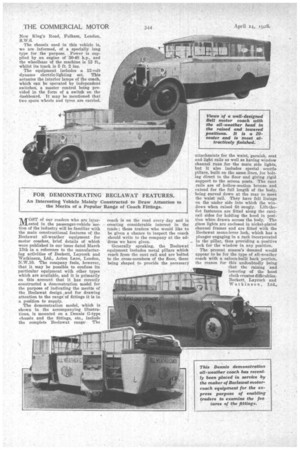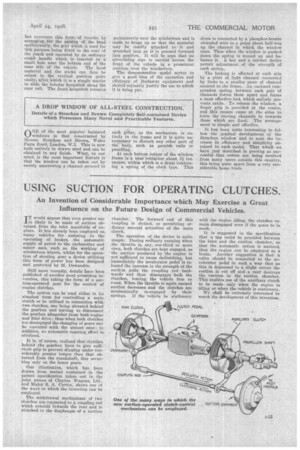FOR DEMONSTRATING BECLAWAT FEATURES.
Page 68

Page 69

If you've noticed an error in this article please click here to report it so we can fix it.
An Interesting Vehicle Mainly Constructed to Draw Attention to the Merits of a Popular Range of Coach Fittings.
MOST of our readers who are interested in the passenger-vehiele 'section of the industry will be familiar with the main constructional features of the Beclawat all-weather equipment for motor coaches, brief details of which were published in our issue dated March 13th in a reference to the manufacturing activities of Beckett, Laycock and Watkinson, Ltd., Acton Lane, London, NAVA°. The company feels, however, that it may be possible to confuse its particular equipment with other types which are available, and it is primarily on this account that it has recently constructed a demonstration model for the purpose of indicating the merits of the Beclawat design and for drawing attention to the range of fittings it is in a position to supply.
The demonstration model, which is shown in the accompanying illustrations, is mounted on a Dennis 0-type chassis and the fittings, etc., include the complete Beclawat range. The coach is on the road every day and is creating considerable interest in •the trade ; those traders who would like to be given a chance to inspect the coach should write to the company at the address we have given.
Generally speaking, the Beelawat equipment includes metal pillars which reach from the cant rail and are bolted to the cross-members of the floor, these being shaped to provide the necessary attachments for the waist, garnish, seat and light raiLs as well as having window channel runs for the main side lights, but it also includes special scuttle pillars, built on the same lines, for bolting direct to the floor and giving rigid support to the screen posts. The cant rails are of hollow-section bronze and extend for the full length of the body, being eurved down at the rear to meet the waist rail. They have felt linings an the under side into which the windows when raised fit snugly. Lift-thedot fasteners are fitted along the cantrail sides for holding the hood in position when drawn across the body. The glass lights are enclosed in nickel-plated channel frames and are fitted with the Beclawat mono-lever lock, which has a plunger engaging in a rack incorporated _ in the pillar, thus providing a positive lock for the window in any position.
The present season's demand would appear to be for the type of all-weather coach with a saloon-built back portion, the reason for this undoubtedly being that the raising and lowering of the hood cloth creates difficulties. Beckett, Laycock and Watkinson, Ltd., has overcome this form of :trouble by arranging for the raising -of.the •head mechanically, the gear which is used for this purpose being fitted to the rear of the coach and operated by an ordinary crank handle which is inserted in• a small hole near the bottom end of the near side of the vehicle. The hood material and the sticks can thus be raised to the vertical position quite easily,. after Which it is a simple matter to slide the tubular hoopstick along the cant rail. The front hoopstick remains permanently over the windscreen and is inadesto hinge up so that the material may be readily attached to it and stretched taut as it is pressed forward into position.. It will be seen that an advertising sign is carried '`across the front of the vehicle in a prominent position over the windscreen.
The demonstration model serves to .give a good idea of the operation and efficiency . of Beelawat equipment and should certainly justify the use to which it is being put.




















































































































